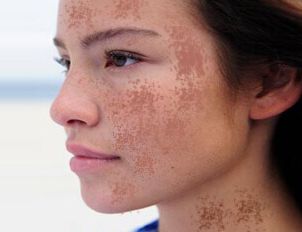CHLOASMA : causes , symptoms , treatments
CHLOASMA
Chloasma , more commonly known as melasma , is an acquired pigmentary disorder of the skin , characterized by areas of discoloration known as hyperpigmentation . Hyperpigmentation refers to the darkening of one's natural skin color due to an increased deposition of melanin , the pigment that determines eye color, skin color , & hair color .
Chloasma can affect both individuals whose assigned at birth is male and those who are assigned as female , it is much more common among those whose birth sex is female . darker - skinned individuals and those who tan easily are at a higher risk than fair skinned individuals , since they naturally have more melanin in their skin .
CAUSES OF CHLOASMA
Chloasma , the pigment - producing cells of the skin become overactive and produce too much melanin , which leads to hyperpigmentation . while the exact cause of chloasma is often unclear , there seem to be several contributing factors associated with its onset . these factors may include having a positive family history of chloasma, unprotected sun exposure , hormonal changes involving estrogen and progesterone , such as during pregnancy , with the use of oral contraceptives ,or while undergoing hormone replacement therapy .
SYMPTOMS OF CHLOASMA
Chloasma presents with irregularly - shaped skin patches that appear darker in color than the surrounding skin and have a net like , or reticulate ,appearance . depending on the site of melanin deposition within the layer of the skin , the color of the lesions can vary from light to dark brown and, occasionally , ash - blue .
The most notably on the cheeks , but can also occur on the nose, upper lip , chin , and forehead . although chloasma does not typically cause symptoms , such as itching or pain , it can cause considerable cosmetic concerns and psychological distress , which may significantly impact the quality of life of the affected individuals .
HOW IS CHLOASMA TREATED ?
There are several treatments options for chloasma , including skin - lightening agents, chemical peels , and laser or light based therapies . skin lightening agents are topical medication that aims to lighten hyperpigmented areas by decreasing melanin production . all of these medications can be used be single agents , or more often , in combination with each other .
Treatments of chloasma can sometimes be challenging , as it tends to be long lasting condition and may reoccur over time . regardless of the chosen treatments , certain measures can be taken to prevent further progressive of chloasma , including avoiding or minimizing sun exposure , using broad spectrum sunscreens , and wearing wide - brimmed hats to protect the face from the sun .


Comments
Post a Comment